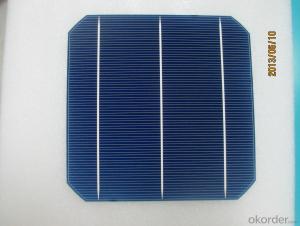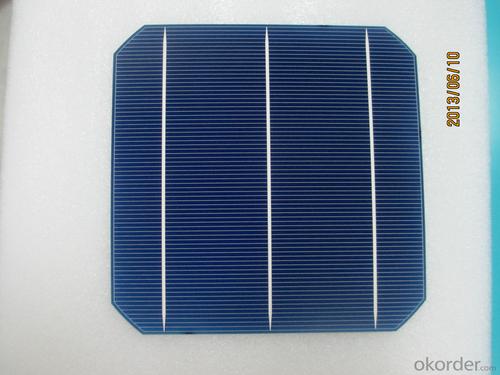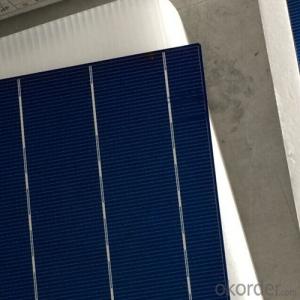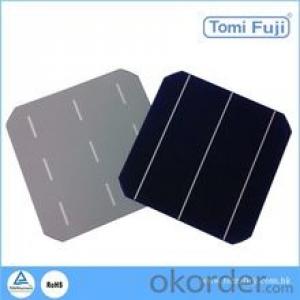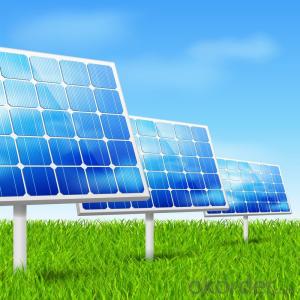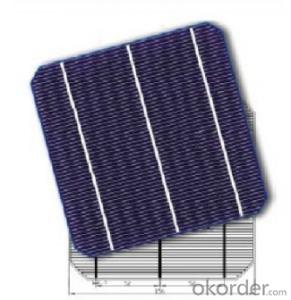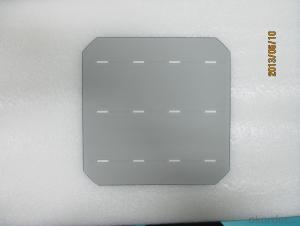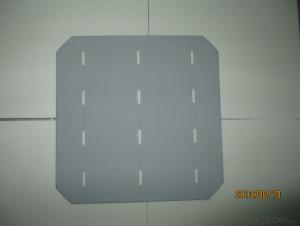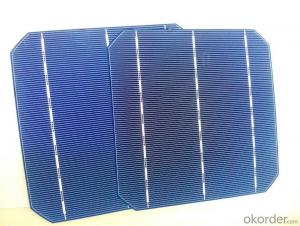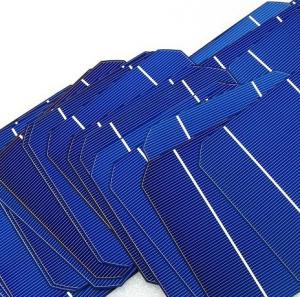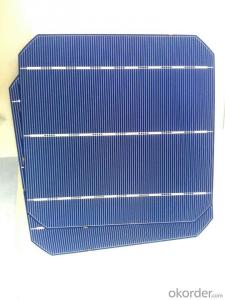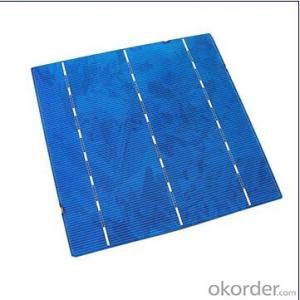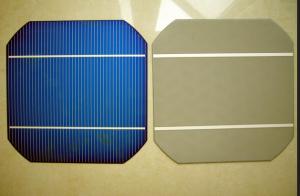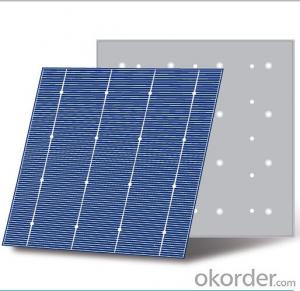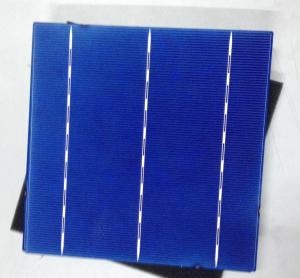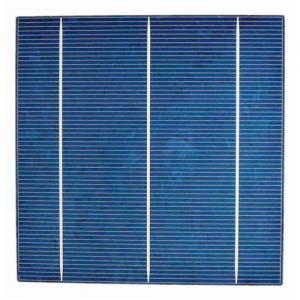Cpv Solar Cells for Sale - Monocrystal Solar Energy Cell 156*156mm Efficiency with Low Price
- Loading Port:
- Tianjin
- Payment Terms:
- TT or LC
- Min Order Qty:
- 10 pc
- Supply Capability:
- 1000000 pc/month
OKorder Service Pledge
OKorder Financial Service
You Might Also Like
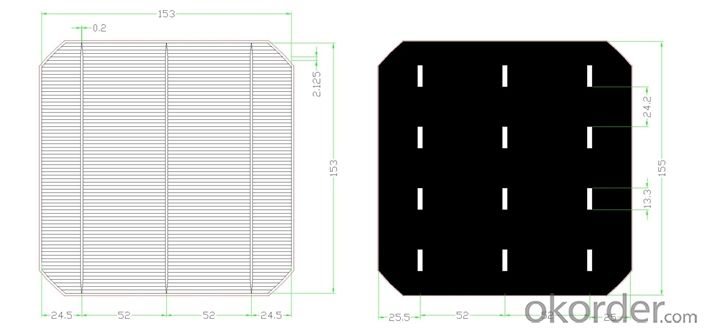
Monocrystal Solar Energy Cell
type:156M
appearance:156×1565㎜±0.5mm;diagonal:R=100mm
Main fence wide:1.4-1.5mm back electrode wide:2-2.5mm
Fence line qty:90
Cell thickness:220um±20um
Eff(%) | 18.00- 18.10 | 18.10- 18.20 | 18.20- 18.30 | 18.30- 18.40 | 18.40- 18.50 | 18.50- 18.60 | 18.60- 18.70 | 18.70- 18.80 | 18.80- 18.90 | 18.9- 19.0 | 19.1- 19.1 | 19.1- 19.2 |
Pm(W) | 4.30 | 4.33 | 4.35 | 4.37 | 4.40 | 4.42 | 4.44 | 4.47 | 4.49 | 4.52 | 4.54 | 4.56 |
Isc(A) | 8.71 | 8.73 | 8.76 | 8.77 | 8.78 | 8.82 | 8.83 | 8.85 | 8.86 | 8.88 | 8.9 | 8.93 |
Im(A) | 8.19 | 8.21 | 8.24 | 8.26 | 8.30 | 8.33 | 8.35 | 8.39 | 8.42 | 8.45 | 8.47 | 8.51 |
Voc(V) | 0.630 | 0.631 | 0.632 | 0.633 | 0.634 | 0.634 | 0.635 | 0.636 | 0.637 | 0.637 | 0.638 | 0.64 |
Vm(V) | 0.527 | 0.528 | 0.529 | 0.531 | 0.531 | 0.532 | 0.534 | 0.534 | 0.535 | 0.536 | 0.537 | 0.538 |
FF(%) | 78.6 | 78.7 | 78.8 | 79.0 | 79.2 | 79.3 | 79.5 | 79.6 | 79.8 | 80 | 80 | 80 |

remark:our company cells as per working current concentrate principle,separate the first and the second grade
Factory Picture of Solar Cells
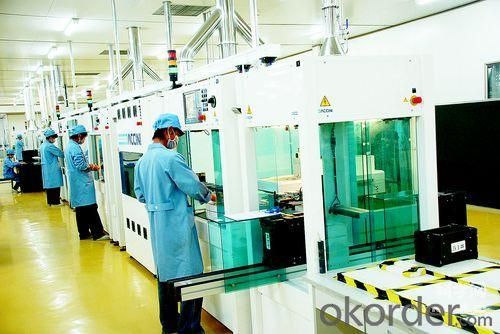
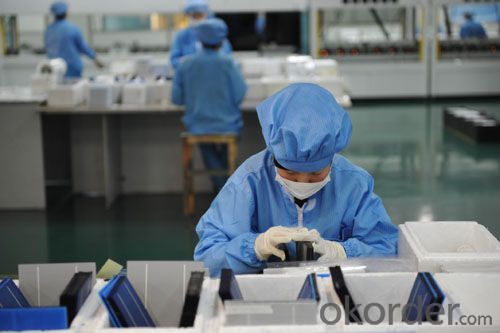
FAQ
We have organized several common questions for our clients,may help you sincerely:
What’s price per watt?
A: It’s depends on the quantity, delivery date and payment terms of the order. We can talk further about the detail price issue. Our products is high quality with lower price level.
Can you tell me the parameter of your solar cells?
We have different series of cells with different power output, both from c-si to a-si. Please take our specification sheet for your reference.
How do you pack your products?
We have rich experience on how to pack the panels to make sure the safety on shipment when it arrives at the destination.
Can you do OEM for us?
Yes, we can.
How long can we receive the product after purchase?
In the purchase of product within three working days, We will arrange the factory delivery as soon as possible. The perfect time of receiving is related to the state and position of customers. Commonly 7 to 10 working days can be served.
Brief introduction of Monocrystal Solar Energy Cell
Silicon rods, materials performance indicators in order to reduce production costs, and now terrestrial applications such as solar cells using solar grade somewhat relaxed. Some also use semiconductor device processing materials and discard the head and tail of silicon materials, solar cells drawn into complex dedicated silicon rods.
The silicon rods cut into pieces, usually 0.3 mm thick sheet. Processing solar cells, the first doping and diffusion in silicon, a trace amount of dopant is generally boron, phosphorus, and antimony. Diffusion is carried out in a quartz tube into a high-temperature diffusion furnace. Thus formed P> N junction on the wafer. Then using a screen printing method, fine with a good paste into a grid line printed on the wafer, after sintering, while forming the back electrode and the surface coated with antireflection gate line source to prevent a large number of photons it is reflected off the smooth surface of the wafer. Thus, the monomer Monocrystal solar energy cells are produced. After single-chip random testing can be assembled according to the required specifications into a solar cell module (solar panel) by the method of series and parallel to a certain output voltage and current.
Difference between Monocrystal Solar Energy Cell and polycrystalline silicon solar panels:
Polycrystalline silicon solar cells and Monocrystal solar energy cells is no different. Life and stability of polycrystalline silicon solar cells and Monocrystal solar energy cells are good. Although the average conversion efficiency of silicon solar cells is higher than the average conversion efficiency of polycrystalline silicon solar cells of about 1%, but because of Monocrystal solar energy cells can be made quasi-square (four to the top of the arc), when the composition of the solar cell module when there is a part of the area filled up, and polycrystalline silicon solar cells are square, there is no problem, so the efficiency of the solar cell module is the same.
In addition, because the manufacturing process two types of solar cell materials is not the same, polycrystalline silicon solar cell manufacturing process energy consumed than Monocrystal solar energy cells is about 30% less.
- Q: Are there any books in the market t about solar cells and their applications?
- The solar was used in the SwissTech Convention Center.
- Q: Where and how can I find more information of Photovoltaic Cells Solar Panels? Can anybody share more about that?
- Photovoltaic cells produce electricity directly from sunlight. Photovoltaic cells are also called PV cells or solar cells. Many PV cells are used in remote locations not connected to the electric grid. Photovoltaic cells comprise the main component in solar panels and are also used to power watches, calculators, solar lights, and lighted road signs.
- Q: What is a polymer solar cell and how does it work?
- Polymer cells are actually a type of thin film solar cell,
- Q: Can solar cells be used in water heating systems?
- Yes, solar cells can be used in water heating systems. Solar thermal collectors, which use solar cells, can capture sunlight and convert it into heat energy to warm water. This technology is commonly used in solar water heating systems, where the heat generated by solar cells is transferred to water in order to provide hot water for various purposes.
- Q: Why are the poly Solar cell specifications is different from each other, they seem to have the different size of 125mm, 156mm, 152mm, is the 152mm's battery technology is higher than the other?
- We used the poly solar cell which is the 125mm size, which is good enough for our usage in the lab.
- Q: How do solar cells perform in cloudy weather?
- Solar cells still generate electricity in cloudy weather, but their performance is reduced. Cloud cover reduces the amount of sunlight reaching the cells, resulting in decreased power output.
- Q: Can solar cells be used in power plants?
- Yes, solar cells can be used in power plants. Solar power plants, also known as solar farms or solar parks, use large arrays of solar panels or solar cells to convert sunlight into electricity on a larger scale. These power plants capture and harness solar energy to generate electricity, making them a sustainable and renewable energy source.
- Q: Can solar cells be used on rooftops with different orientations?
- Yes, solar cells can be used on rooftops with different orientations. While the ideal orientation for maximum solar energy production is typically facing south, solar panels can still generate electricity when installed on rooftops facing east, west, or even north. The efficiency and energy output may be slightly lower, but advancements in solar technology and the ability to tilt and adjust panel angles can help optimize energy production on rooftops with varying orientations.
- Q: What factors affect the output of a solar cell?
- The factors that affect the output of a solar cell include the amount of sunlight it receives, the efficiency of the cell itself, the temperature, and any shading or obstructions that may block the sunlight.
- Q: Solar cell life for several years
- A solar cell is a device that converts light energy directly into electrical energy by photoelectric effects or photochemical effects.
Send your message to us
Cpv Solar Cells for Sale - Monocrystal Solar Energy Cell 156*156mm Efficiency with Low Price
- Loading Port:
- Tianjin
- Payment Terms:
- TT or LC
- Min Order Qty:
- 10 pc
- Supply Capability:
- 1000000 pc/month
OKorder Service Pledge
OKorder Financial Service
Similar products
Hot products
Hot Searches
Related keywords
